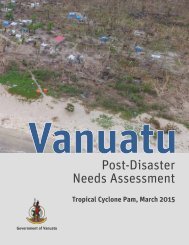Fiji
yqgk302EGjo
yqgk302EGjo
Create successful ePaper yourself
Turn your PDF publications into a flip-book with our unique Google optimized e-Paper software.
FIJI Post-Disaster Needs Assessment<br />
2002/2003 and the 2013/2014 HIES, 25,26 whereas the incidence of poverty in urban areas declined from 28 to 18 percent<br />
between 2002/2003 and 2008/2009 before increasing slightly to 20.8 percent as reported by the 2013/2014 survey. 27 The<br />
growing population living in more than 200 informal settlements in major towns and cities is contributing to this increase.<br />
Additionally, rural poverty increased slightly between the 2002/2003 and the 2008/2009 surveys due to the decline in the<br />
sugar industry and reduced loans to agriculture. However, the 2013/2014 HIES indicated a decline in the incidence of rural<br />
poverty, taking it below the 2002/2003 level, which is a result of the broader spread of economic opportunities emanating<br />
from the various government programmes that have targeted rural communities through training programmes and job<br />
creation. 28<br />
Table 8: Incidence of Poverty (percent) by Division<br />
Household<br />
Income<br />
Expenditure<br />
Surveys<br />
2002/2003 2008/2009 2013/2014 Total Population<br />
Population<br />
Living below<br />
the Basic<br />
Needs Poverty<br />
Line during<br />
the Period<br />
2013/2014<br />
Urban Central 24 16 8.0 259,941 20,795<br />
Eastern 42 30 29.3 3,661 1,073<br />
Northern 39 38 34.8 33,205 11,555<br />
Western 33 17 22.1 133,944 29,602<br />
Rural Central 29 36 35.8 98,335 35,204<br />
Eastern 35 40 42.5 35,824 15,225<br />
Northern 57 51 52.1 101,116 52,681<br />
Western 38 43 26.5 179,239 47,498<br />
National 35 31 28.4 845,265 240,055<br />
Source: <strong>Fiji</strong> Bureau of Statistics. Household Income Expenditure Surveys 2002/2003, 2008/2009 and 2013/2014.<br />
In examining the incidence of poverty by division, the Northern Division continues to record the highest rate. 29 While the<br />
Western Division has the highest absolute number of rural people falling below the basic needs poverty line, the division has<br />
the lowest incidence of rural poverty (26.5 percent) as a proportion of the population. This level is half that of the rural north<br />
and almost ten percent less than the rural parts of the Central Division. The rural poverty rate fell sharply in the Western<br />
Division between 2009 (43 percent) and 2013/2014 (26.5 percent), which largely reflects the increase in employment<br />
associated with the tourism sector.<br />
Social Protection<br />
The government has put in place a range of social protection programmes to help those families struggling to meet their<br />
basic needs, including the: Poverty Benefit Scheme (PBS); Child Protection Allowance (CPA); Food Voucher Programme<br />
(FVP); Social Pension Scheme (SPS); the Bus Fare Subsidy; and the Expanded Food Voucher Programme for pregnant<br />
women in rural areas. These programmes are monitored by the Ministry of Women, Children and Poverty Alleviation, which<br />
ensures that assistance reaches the targeted groups.<br />
Since 2012, the government has allocated more than F$125 million to the four major social protection programmes, with<br />
a similar amount every year since then (Figure 14). While overall basic needs poverty levels have improved slightly, these<br />
figures show that the demand for social protection from vulnerable families has remained constant over time. It also shows<br />
the government’s commitment to provide social protection for the poor and vulnerable sectors of the population. Annex<br />
3: Supplementary Material for Employment, Livelihoods and Social Assessment provides a comprehensive overview of<br />
the various poverty alleviation programmes implemented by the government since 2009 and the corresponding budget<br />
allocations for each programme.<br />
27<br />
According to the National Housing Policy 2011, over 15 percent of the urban population resides in over 200 informal settlements<br />
(squatters) in <strong>Fiji</strong>’s major towns and cities. The Greater Suva area, including Nasinu, has the largest number of squatters.<br />
28<br />
Draft National Development Plan.<br />
29<br />
The BNPL has two components; the Food Poverty Line (FPL) and the Non-Food Poverty Line. The FPL consists of a basket of foods which<br />
for the 2002/2003 analysis was derived from the expenditure patterns derived from the middle quintile (20 percent) of the rural and urban<br />
groups of the major ethnic groups.<br />
Tropical Cyclone Winston, February 20, 2016<br />
31



